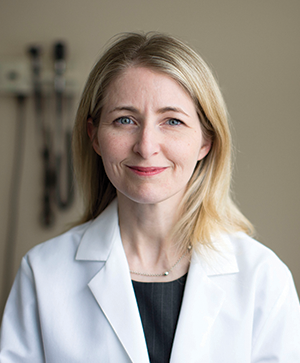On the cover page of the immunology textbook Victoria Shanmugam used in medical school was a quotation that resonated with the young Londoner: “Immunology is the invention of the devil, who is making it up as he goes along because he is not too clear about this stuff either.”

Years later, Shanmugam, M.B.B.S., MRCP, associate professor of medicine and director of the Division of Rheumatology at GW’s School of Medicine and Health Sciences (SMHS), fully understands that the devil is in the discovery. As a rheumatologist, she finds her expertise crosses many disciplines. When she needed control subjects for a study of the immunology of wound healing (see sidebar), a surgeon colleague suggested some patients with hidradenitis suppurativa (HS) — a chronic inflammatory disease of the apocrine sweat glands. Shanmugam pursued patients with HS, believing they would have more normal wound healing, which turned out not to be the case. In the spirit of accidental discovery, she says, “we now have a cohort of patients ... and a spectacular opportunity to study HS.”
HS is a relatively unstudied disease, a medical “orphan,” yet its impact on work and society belies its low research status. It affects between 1 and 4 percent of the U.S. population — the equivalent of the residents of Los Angeles and New York City combined. That is more than the number of people suffering from rheumatoid arthritis (RA), and yet no one is throwing money its way. In the past seven years, Shanmugam says, HS has received just $270,000 in federal funding, compared to the millions of dollars spent each year supporting RA research.
HS is a terrible disease. It is characterized by clusters of abscesses or subcutaneous boil-like “infections” (oftentimes free of actual bacteria) that most commonly affect apocrine sweat gland–bearing areas, such as the armpits, ear canal, and eyelids. The disease causes chronic inflammation with open wounds in the armpits, groin, breasts, inner thighs, and buttocks. HS outbreaks are painful in tender areas and may persist for years with interspersed periods of inflammation, often culminating in sudden drainage of pus. This process often forms open wounds that will not heal and frequently leads to significant scarring. Incision and drainage procedures may provide symptomatic relief. HS flare-ups may be triggered by emotional stress, sweating, hormonal changes, and humidity, and the condition is exacerbated by friction from clothing. Smoking and obesity are thought to be contributing factors. Bacterial infections and cellulitis (deep tissue inflammation) are other common complications of HS.
Depression and physical pain frequently accompany HS and can be difficult to manage. Sufferers are often malodorous. HS can go undiagnosed for years because patients’ embarrassment can cause them to delay seeking treatment. The disease is not contagious. There are indications that it is hereditary among certain ethnic groups and that it is autoimmune in nature. In the United States, it disproportionately affects young African-American women. Onset is most common in the late teens and early 20s.
“As you can imagine, this disease significantly impacts quality of life,” Shanmugam says. “Folks with this disease find it difficult to hold down a job; their disease flares can impact personal relationships; and the lesions themselves are incredibly painful.” Due to the fact that it falls between medical specialties, Shanmugam continues, studies have shown that patients with HS have higher utilization of the emergency room and other high-cost medical services than patients with other inflammatory skin disorders. “On many levels there is an unmet need to better understand the drivers of this disease,” she explains.
In Washington, D.C., a majority African-American community, Shanmugam has found no shortage of cases to examine. “We recently established a clinic dedicated to the care of patients with HS, and there are multiple specialties at GW interested in treating these patients, including dermatology, urology, plastic surgery, general surgery, and infectious diseases. Our goal is to help these patients get more focused and coordinated care from a team of doctors with expertise in HS management,” she says. “Clinically, now I harness some of the immune treatments used to treat diseases such as rheumatoid arthritis to treat HS with some success, but through our laboratory, we are also working on understanding at a molecular level the pathways that drive HS.”
Her team has been testing the host immune response in tissue samples from HS patients. Then they are profiling the bacteria contained in the samples from the infected site. Thus far, they have determined that patients who have been treated with immune suppression drugs have less active disease. “With HS patients who have had surgery, if you treat them post-op with immuno-suppressants — tumor necrosis factor inhibitors such as Humira and Remicade — they have a lower risk of recurrence, and if [HS] does return, it is less severe than in those who are not treated with immuno-suppressants,” says Shanmugam. “Once you get this under control, it’s amazing how positively it affects their quality of life.”
Shanmugam, who graduated from the same London medical school as Douglas Nixon, M.D., Ph.D., chair of the Department of Microbiology, Immunology, and Tropical Medicine and Walter G. Ross Professor of Basic Science Research at SMHS, says: “One of the great things about being a physician scientist is that by making observations at the bedside, you can really focus on what factors seem to be clinically important, and this is one of the missions of our laboratory — we are really focused on translating observations from the bedside to understand them at a molecular level so that we can accelerate research in immune diseases.”
As for the quotation in her immunology text, Shanmugam says, “I use the quote in a talk I give to the medical students. It’s from a journalist named Janice Hopkins Tanne, who had written a piece for the British Medical Journal where she interviewed doctors about their least favorite parts of medical school. I loop it in to a discussion about the Tasmanian devil, because they were at risk of becoming extinct due to one of the few forms of transmissible cancer. The animals are susceptible because they have been so inbred, they do not have enough genetic diversity in their immune system to recognize self and non-self. It makes a good hook to help the students realize how important the immune system is, why genetic diversity is important, and what can happen when things go wrong.
“There was a time, during medical school, when I agreed with that quote,” she continues. “But seeing rheumatology in the clinic totally changed my understanding of immunology — suddenly all these pathways that seemed so unintelligible became real, and I could see how modulating them impacted my patients. Immunology is defining the future of medicine, and it is great to be a part of a strong team helping to grow immunology at GW.”
Bugged By Chronic Wounds
Why do some wounds fail to heal? Why do some wounds heal faster than others? How can we accelerate the process of wound repair?
Victoria Shanmugam’s lab at the GW School of Medicine and Health Sciences (SMHS) has developed a rapid method of detecting bacteria in wounds, which could result in more effective and efficient treatment and lower health care costs. Shanmugam, M.B.B.S., MRCP, associate professor of medicine and director of the Division of Rheumatology at SMHS, heads the National Institutes of Health–funded WE-HEAL study, a longitudinal investigation of the interplay between the host immune response and the wound bed microbiome in patients with chronic wounds. The study has three major components: 1) using molecular analysis of the tissue from wounds to investigate the immune response in wound healing; 2) working with the J. Craig Venter Institute to profile the microbiome of these wounds; and 3) investigating symptoms associated with these chronic wounds.
“The project developed out of an interest in people who had immune issues and problems with healing wounds,” says Shanmugam. “I started studying the bacteria that live in wounds, and it’s become clear that there are some patients, for unknown reasons, who chronically are colonized with bacteria within the wound. “I’m looking to see if there are factors in the host immune system that predict clinical outcomes — who is going to heal and who is not,” she continues. “One of the factors we’re looking at is the bugs that live in the microbiome, so this involves sampling the microbiome and sequencing the genetics of the bacteria living in the wound.”
By chance, Shanmugam stresses, they found that the bacteria Pseudomonas, commonly found in infected chronic wounds, produces a chemical, pyocyanin, that is electrically active. The team developed an inexpensive, inch-long disposable electrochemical sensor that can immediately detect the presence of the chemical and, thus, the bacteria.
“Right now there’s no method for bedside testing for infection,” Shanmugam says. “Being able to detect Pseudomonas and other organisms at the time of the clinic visit will greatly enhance our ability to deliver timely patient care.”
Pseudomonas was the fourth most common organism found in the microbiome profiles of chronic wounds explored in the WE-HEAL study. “We compared profiles from our wound samples with data from the human microbiome project (in which totally normal subjects had their skin microbiome profiled), and Pseudomonas was extremely rare in normal skin,” says Shanmugam.
Her team also wondered if they could show differences between the patients whose pain was more aggressively treated using opioid analgesics and those who received lower doses or no opioids at all. When the data was analyzed, they realized an original hypothesis was wrong. The patients who received higher doses of opioids had slower rates of healing. “This is really interesting because it suggests that perhaps we are impairing wound healing in these patients by trying to give them opioid analgesics,” says Shanmugam. “Now my team is starting to look into this to see if we can understand the mechanisms by which these medications may be contributing to delayed healing.”
Shanmugam has applied for funding for the next step — using molecular methods to screen wound fluid for other molecules that might predict either the microbiome profile or the clinical outcome. “We have found a unique bacterial profile that seems to be predictive of poor outcome in patients in the WE-HEAL study,” she explains. “If we can find a way to detect this combination of bacteria using similar quorum-sensing molecules, then there’s a chance of developing a bedside tool to help clinical decision making.”



